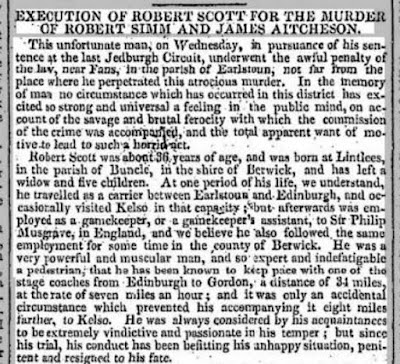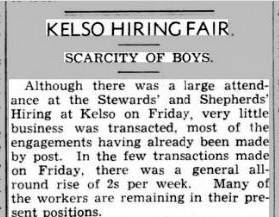THE EARLY YEARS
In the 1820s George Lindsay was the Earlston Post Master, listed in the 1825 edition of Pigot & Co Commercial Directory of Scotland as a grocer, spirit dealer and hardware man, in addition to being Post Master. The address of his grocery shop isn’t given, but it is possible that it was the building currently (2019) occupied by “One Stop” on the High Street. That being the case, Lindsay’s next door neighbour would have been John Spense.
John Spense took over the role of Postmaster on LIndsay's death in 1836. Spense was a writer, (an old Scottish term for a solicitor), justice of the peace, clerk and agent to the Norfolk Fire Office. We know that Spense lived in a house on the High Street now known as Market House.
The railway did not reach Earlston until 1863, so post in earlier times was carried by three coach services:
- The Commercial Traveller ran between Coldstream and Edinburgh. It left Earlston every Monday, Wednesday and Friday leaving at twelve thirty Coldstream and returned on Tuesday, Thursday and Saturday at ten in the morning.
- The Tweedside Coach ran between Kelso and Earlston, leaving Earlston at one o’clock in the afternoon and returning in the morning at ten for Edinburgh.
- The Royal Eagle served as the link between the Borders and Edinburgh
By 1837, the coach service was limited to the Tweedside. The coach left Earlston (from Kelso) to Edinburgh at nine-thirty every morning except Sundays. The return service to Kelso (from Edinburgh) left each afternoon, except Sundays, at half-past one. For the villagers, this meant that letters arrived at half-past two each afternoon and were dispatched at seven each morning.
The Ordnance Survey published “Name Books” which provide information on the names found in various parishes covered by Ordnance Survey maps. Berwickshire OS Name Books, 1856-1858, Volume 16 contains information on place names found in the parish of Earlston.
The description of the Earlston Post Office for 1856-1858 read:
"An apartment of a dwelling house is occupied as an office where letters are received and dispatched to and from Melrose daily also to Legerwood, Gordon, Fans and Redpath etc. Mrs. Spense Post Mistress."
By the late 1850s, the railway on the Waverley Line, had reached Melrose. As a consequence, a coach from Earlston provided a twice-daily service (Sundays excepted) in connection with the railway. Nonetheless, the service offered by the Post Office had increased. Letters “from all parts” arrived from Melrose every morning at half-past eleven and each evening at eight. Mail was dispatched every morning at seven-twenty and again in the afternoon three-fifty. A Sunday service had now been established with letters arriving at eleven and dispatched at seven-thirty in the morning. Money Orders were also granted and paid.
UNCERTAIN TIMES - WHO WAS TO BE THE NEXT POSTMASTER?
A significant impact on the postal services in Earlston occurred in In late December of 1859, when Margaret Spense died of acute bronchitis at the age of 63. As a consequence, the Post Master position was vacant.
The Berwickshire MP, David Robertson, 1st Baron Marjoribanks, called for a meeting to be convened on January 19, 1860, in the West UP Church and chaired by Charles Wilson of Wilson and Sons.
The purpose of the meeting was to choose the new Post Master. Four candidates were in the running and, after a secret ballot, Mr. Ralph Dodds, an Earlston merchant, was elected with a majority of 97 votes.
"The Kelso Chronicle" at the time reported:
“We cannot doubt, but the decision of this meeting will give general satisfaction. Mr. Dodds is a highly respectable, deserving, and trustworthy person, one who will do his utmost to please and accommodate the public.”
Such praise and optimism were to prove misplaced.
Just two years and two months after accepting the post, Ralph Dodds resigned stating that the salary of £8 per annum was insufficient. To give this salary some context, in 1897 a three bedroom house at 4 Rodger’s Place in Earlston was available for an annual rent of £11.
A meeting was convened on March 27, 1862, in the Reading Room under the chairmanship of Charles Wilson and it was concluded that the government undervalued the Post Master’s position and Mr. Robertson was asked to use his influence in obtaining an increase for Mr. Dodds.
A follow-up meeting was held at the end of April. A salary increase was not forthcoming and, Mr. Thomas Clendinnen, a draper in the village, who had offered his services as postmaster, withdrew his offer. The Post Master role was offered to the Legerwood and Melrose “districts runners”, but both declined. Obviously, Post Master was not seen as a desirable position. The meeting concluded with the action to canvas the villagers for a volunteer.
THE CROCKETT-MCWILLIAM YEARS
In the mid-1850s, William Crockett arrived in Earlston and in 1857 married Margaret Wood. In the 1861 census William was working as a Power Loom Tuner, but five years later was listed in Rutherfurd's Southern Counties Directory of 1866 as postmaster.
"Mail arrives 10.40am & 7pm and is collected 6.30am, and 6pm with the promise that letters are delivered immediately after arrival. Postmaster is William Crockett with David Trotter and David Swanston post-runners.Ten years on in the 1871 census, William’s occupation was Post Master, and his wife was listed as Post Mistress.
In the same census, was listed on the High Street Ann McWilliam, a grocer and the widow of Alexander McWilliam Around 1858, Alexander McWilliam, his wife Ann and daughter Annie arrived in Earlston from Midlothian and set up a grocery business in what is now Tom Davidson Art Gallery. A second daughter, Mary was born in 1859.
On November 27, 1860, Alexander was making his rounds, selling to customers and picking up produce from farmers when he slipped and fell from his cart. He had sustained a head injury and died at home the following day. He was just thirty-six years old and left two young children and a heavily pregnant wife. His son, Alexander, was born in 1861.
In 1872, William Crockett died aged 54, and eight years later we know that Margaret Crockett was working as a grocer while Annie McWilliam (Alexander and Ann McWilliam’s eldest daughter) was Post Mistress.
It seems reasonable to assume that following the death of Alexander, Ann McWilliam would have welcomed the opportunity to grow the business by incorporating the post office into her shop. However, she was a single mother with a young family, and the Post Mistress position with the increased services offered by the Post Office may have been too daunting to take on.
We know that the Post Master position was not desirable, but with the right premises, it could offer better employment for William Crockett than that of Power Loom Tuner.
It is possible, therefore, that the two families came together, McWilliams with the shop on the High Street and Crockett with the Post Master position.
It would certainly explain the “Post Office” sign on the stonework still visible today.
Below a photograph of what is now Tom Davidson Gallery. Note - just visible “Post Office” etched into the stone of the right side of the doorway.
In 1886, David Lochhead, jeweller, took over the premises occupied by the post office.
THE WEATHERLY YEARS
In 1886, Thomas Weatherly became Post Master, and the post office moved to his stationers, bookshop and bookbinding shop further along the High Street. (Currently Lucky Finds).
In 1889, Thomas’ son, John P Weatherly became Post Master. The middle initial “P” was in honour of Thomas’ wife’s maiden name of Patterson.
In addition to the family business of stationer, printer and bookbinder, John appears to have developed a portfolio of property. The 1891-1892 Valuation Roll shows John owning - a House and Back Premises (later described as a Shop); 2 other Houses; a House with Stable; a Weaving Shop and a Smithy.
The “Postie Close”, out of shot but to the right in the photograph below, served as a convenient link connecting the village to the church via the road.
But take a closer look at that newspaper placard outside the shop, which announces that "Crippen Removed to Hospital" - the date Septembers 2nd 1910.
Dr.
Hawley Harvey Crippen, was an American doctor He was hanged 23rd
November 1910 in Pentonville Prison, London for the murder of his wife
Cora Henrietta Crippen, and was the first criminal to be captured with
the aid of wireless telegraphy.
John P. Weatherly continued to hold the position of Post Master until his death in 1907 when Margaret Weatherly, his wife took over the role. Following her death in 1914 at the age of 53, her elder daughter Ellen Sarah Patterson Weatherly (her middle names from her grandmother) became Post Mistress, with younger daughter Margaret assisting in the shop - her occupation was listed in the Tradeand Commercial Directories as “Book Seller”. Margaret died in 1970 at the age of 79, the same year as her sister Ellen.
Taking over the business was John P. Weatherly, (1924-2006), known to some of today's Earlstonians. Born in 1923, he followed the family tradition of having Patterson as his middle name. His parents, Edward and Mary Weatherly, lived in Lauder where Edward worked as a baker.
John was a popular man, and he involved himself with many of the community’s groups. In 1963, he married Mary Rodger, a teacher who taught many of today's villagers at Earlston Primary School.John also earned a reputation as a local historian, gathering a wealth of material, which forms the basis of the archive collection of the Auld Earlston Group.
FULL CIRCLE
When John retired, the Post Office was relocated to the Spar Convenience Store now “One Stop” grocer, thus going full circle from the 1820s. The service was later incorporated into the main grocery business until its sudden closure in March 2017.
It took nearly a year of campaigning, before the village benefited again from a post office service, with the introduction of a “mobile post office,” i.e. a van Wednesday and Friday afternoons only.
****************
With grateful thanks to blog reader Jeff Price for contributing this article.
************
SEE ALSO: "Earlston's Posties of the Past" HERE
NOTE: "The Changing Face of Earlston" is the theme of the next
Auld Earlston Exhibition & Slide Show,
when the focus will be on over 200 years of local shops and businesses.
The Dates: June 22nd and 23rd 2019 in the Church Hall. Details to follow.























